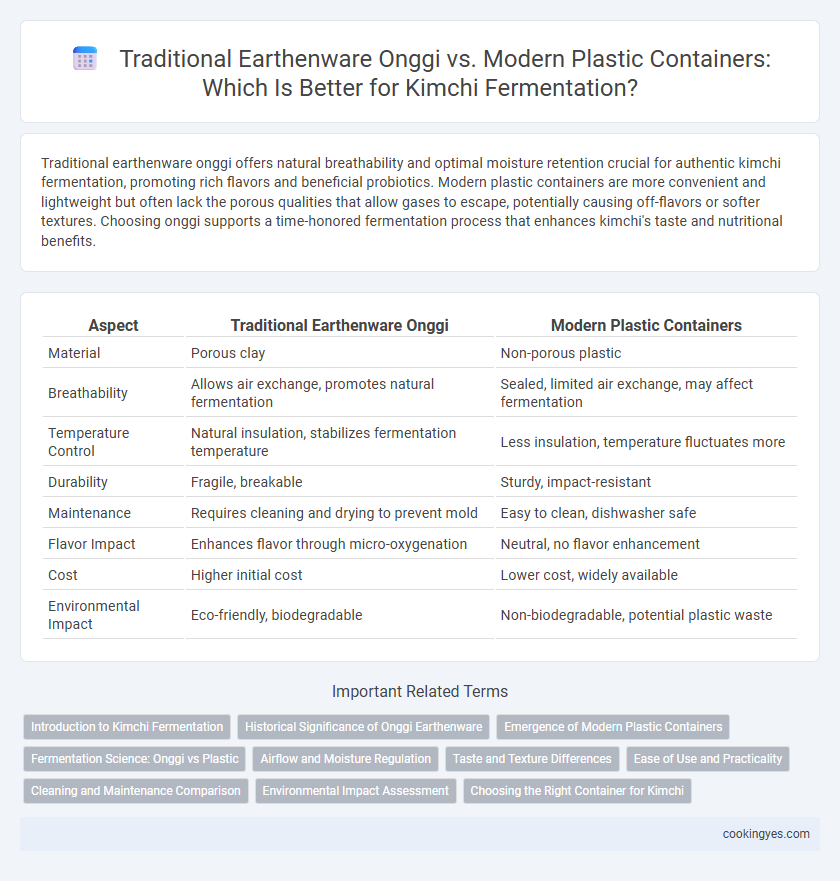Traditional earthenware onggi offers natural breathability and optimal moisture retention crucial for authentic kimchi fermentation, promoting rich flavors and beneficial probiotics. Modern plastic containers are more convenient and lightweight but often lack the porous qualities that allow gases to escape, potentially causing off-flavors or softer textures. Choosing onggi supports a time-honored fermentation process that enhances kimchi's taste and nutritional benefits.
Table of Comparison
| Aspect | Traditional Earthenware Onggi | Modern Plastic Containers |
|---|---|---|
| Material | Porous clay | Non-porous plastic |
| Breathability | Allows air exchange, promotes natural fermentation | Sealed, limited air exchange, may affect fermentation |
| Temperature Control | Natural insulation, stabilizes fermentation temperature | Less insulation, temperature fluctuates more |
| Durability | Fragile, breakable | Sturdy, impact-resistant |
| Maintenance | Requires cleaning and drying to prevent mold | Easy to clean, dishwasher safe |
| Flavor Impact | Enhances flavor through micro-oxygenation | Neutral, no flavor enhancement |
| Cost | Higher initial cost | Lower cost, widely available |
| Environmental Impact | Eco-friendly, biodegradable | Non-biodegradable, potential plastic waste |
Introduction to Kimchi Fermentation
Traditional earthenware onggi, made from breathable clay, allows optimal air exchange and moisture regulation essential for kimchi fermentation, fostering the growth of beneficial lactic acid bacteria. Modern plastic containers, while convenient and lightweight, often lack the porous structure of onggi, which can result in uneven fermentation and reduced depth of flavor. The micro-oxygen environment provided by onggi contributes to kimchi's distinct tang and texture, making it a preferred choice for authentic fermentation processes.
Historical Significance of Onggi Earthenware
Onggi earthenware has been integral to Korean kimchi fermentation for centuries, offering natural breathability and moisture regulation essential for developing authentic flavors. This traditional pottery, crafted from clay and fired at high temperatures, fosters beneficial microorganisms while preserving the kimchi's texture and aroma. Despite the rise of modern plastic containers, onggi remains valued for its cultural heritage and superior fermentation environment.
Emergence of Modern Plastic Containers
Modern plastic containers have emerged as a popular choice for kimchi fermentation due to their affordability, lightweight nature, and airtight seals that help maintain consistent fermentation conditions. Unlike traditional earthenware onggi, plastic containers do not allow for natural air exchange, which can alter the kimchi's texture and flavor profile. The rise of plastic containers reflects a shift towards convenience and scalability in kimchi production, especially in urban households and commercial settings.
Fermentation Science: Onggi vs Plastic
Traditional earthenware onggi offers superior gas permeability and micro-oxygenation, creating an optimal environment for lactobacilli growth during kimchi fermentation. In contrast, modern plastic containers are airtight, limiting oxygen exchange and potentially leading to anaerobic conditions that can alter microbial activity and kimchi flavor. Studies in fermentation science highlight that the porous structure of onggi enhances beneficial microbial diversity and fermentation consistency compared to plastic vessels.
Airflow and Moisture Regulation
Traditional earthenware onggi excels in airflow and moisture regulation due to its porous structure, allowing kimchi to ferment naturally while preventing excess moisture buildup. In contrast, modern plastic containers offer a more airtight environment that can trap moisture, potentially leading to over-fermentation or off-flavors. The natural breathability of onggi promotes optimal fermentation conditions, preserving the authentic taste and texture of kimchi.
Taste and Texture Differences
Traditional earthenware onggi promotes natural air circulation and microbial activity, enhancing the complex flavors and crunchy texture of kimchi through slow fermentation. Modern plastic containers create an airtight environment, accelerating fermentation but often resulting in a milder taste and softer texture. The porous nature of onggi is crucial for developing the rich umami and crispness that plastic containers typically lack.
Ease of Use and Practicality
Traditional earthenware onggi excels in maintaining optimal airflow and moisture balance essential for kimchi fermentation, though it requires careful handling and significant space. Modern plastic containers offer superior ease of use with lightweight design, airtight seals, and stackability, making them practical for everyday kitchen use without compromising fermentation quality. Choosing between onggi and plastic depends on balancing authentic fermentation benefits with convenience and storage limitations.
Cleaning and Maintenance Comparison
Traditional earthenware onggi provides natural breathability that promotes consistent fermentation while requiring careful cleaning with gentle brushing to avoid damage and preserve its porous surface. Modern plastic containers offer easy-to-clean, non-porous surfaces that resist staining and odors but may lack the micro-oxygenation qualities essential for authentic kimchi flavor development. Maintenance of onggi involves periodic airing and drying to prevent mold, whereas plastic containers demand routine thorough washing and sanitizing to avoid contaminant buildup.
Environmental Impact Assessment
Traditional earthenware onggi allows natural air circulation and microbial activity crucial for kimchi fermentation while being biodegradable and environmentally sustainable, decomposing without releasing toxins. Modern plastic containers, although convenient and lightweight, contribute to plastic pollution and environmental degradation due to their non-biodegradable nature and potential chemical leachates during fermentation. Assessing environmental impact favors onggi for its eco-friendly lifecycle and minimal carbon footprint compared to the production and disposal consequences of plastic containers.
Choosing the Right Container for Kimchi
Traditional earthenware onggi offers superior breathability and moisture regulation, crucial for authentic kimchi fermentation by allowing gases to escape while maintaining an optimal environment for beneficial bacteria. Modern plastic containers provide convenience and airtight seals, reducing contamination risks and ensuring consistent temperature control but may lack the natural airflow that enhances flavor development. Selecting the right container depends on balancing traditional fermentation benefits with practical storage needs, emphasizing vessel material's impact on kimchi's taste and texture.
Traditional Earthenware Onggi vs Modern Plastic Containers for fermentation Infographic

 cookingyes.com
cookingyes.com